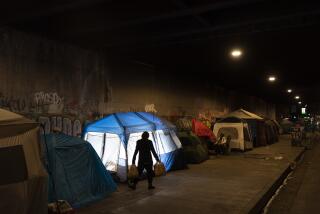Life on the Street
- Share via
Life on the street is hard, and it takes the cunning of a cat to survive its perils.
You have to sleep with your eyes half-open, be adept at finding food and cringe with suspicion at the hands of friendship that reach out toward you.
But even harder in a way is explaining why you’re there in the first place without a home, without work and without a lot of hope for the future.
I’ve heard all kinds of reasons from those who wander the streets of L.A., but none more immediately compelling than the tale told by Alice Baker.
That isn’t her real name but she’s real, one of the 100,000 homeless people in the county living in parks, in doorways and under piers, scratching out a minimal existence and refining the skills that keep them alive.
Alice is a tiny, gray-haired woman in her late 50s who was found sleeping on a bench in MacArthur Park. An outreach worker for a homeless shelter brought her in to get her off the street and to arrange a new start on life.
It was at the shelter that Alice, a precise and oddly cultured woman, told a story that, one listener said, had everyone in tears. A volunteer worker, overwhelmed by its impact, wrote me about it.
“This little woman with the lively brown eyes,” the letter said, “witnessed the killing of her four children by her deranged husband, had a nervous breakdown and took to the streets.”
Alice Baker, it seemed, was the victim of a horror that would forever shadow her life.
*
I spoke with her at the shelter, a pleasant cluster of buildings north of downtown L.A. She weighs just over 100 pounds, her hair is neatly trimmed in a pageboy and her gestures bird-like in their quickness.
There was much she couldn’t remember, Alice said. The murder of her children in 1966 had shut years of her life into darkness, the way one closes the door on an attic, leaving its contents in mystery.
What she does recall, she says, is this:
She was married to an Air Force enlisted man stationed in Germany, and she joined him there. They had two sets of twins, all boys. Her husband was a quiet man with an explosive temper. One day she returned from shopping to find that he had snapped and was barricaded in the house with their children.
“I heard my baby screaming and smashed a window,” she said to me in a manner that seemed eerily detached. “I climbed inside and what I saw my mind wouldn’t accept. He had hacked our children to death with a fishing knife.”
The next four years of her life, she says, vanished in the attic’s darkness. When she awoke, she was using a different name and was a student at Milwaukee’s Marquette University.
Slowly, she told me that day in a small room of the homeless shelter, the memory of what happened is returning and she is undergoing therapy to merge the two people she had become into one person.
En route to that day, she says, she has shoplifted, forged checks, served time in prison and spent years living on the street.
*
It isn’t unusual for the homeless to reinvent their lives as a way of explaining an existence that is otherwise unexplainable, and it appears that Alice Baker may have done just that.
Military archives confirm that she was married to an Air Force enlisted man but the files contain no indication of a homicide. A spokesman says that Alice’s husband, in fact, was granted a hardship discharge to raise their only son because his wife had abandoned them.
Of her entire story, only Alice’s time in prison for theft and forgery could be confirmed. Her ex-husband, now remarried and living in the South, could not be reached for comment, though his older brother says emphatically there was no murder, they had only one son who is now 35 and that Alice left them without so much as a goodbye.
“She had mental problems,” the brother said. “I feel sorry for her, but her story is false. And she was such a beautiful girl. . . .”
Alice seemed stunned that her tale was unraveling, but could offer nothing substantial to prove that it was true. Vague hints of a relative who could verify what she’d told me, and what she’d told those at the homeless shelter, never materialized.
It’s easy to say that the story is a lie, another slick con by a wily street person, but that may be too harsh. To Alice, it might be quite real, a fantasy to justify failure that has assumed a reality of its own on a different level. She may truly endure the horror of an event that occurred only in the darkness of an attic where strange and scary things dwell.
Even bad dreams have a way of staying around a long, long time.
Al Martinez can be reached online at [email protected]
More to Read
Sign up for Essential California
The most important California stories and recommendations in your inbox every morning.
You may occasionally receive promotional content from the Los Angeles Times.










